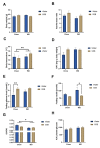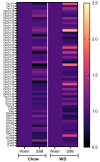Long-Term Consumption of a Sugar-Sweetened Soft Drink in Combination with a Western-Type Diet Is Associated with Morphological and Molecular Changes of Taste Markers Independent of Body Weight Development in Mice
- PMID: 35276952
- PMCID: PMC8837962
- DOI: 10.3390/nu14030594
Long-Term Consumption of a Sugar-Sweetened Soft Drink in Combination with a Western-Type Diet Is Associated with Morphological and Molecular Changes of Taste Markers Independent of Body Weight Development in Mice
Abstract
We investigated whether the long-term intake of a typical sugar-sweetened soft drink (sugar-sweetened beverage, SSB) alters markers for taste function when combined with a standard diet (chow) or a model chow mimicking a Western diet (WD). Adult male CD1 mice had ad libitum access to tap water or SSB in combination with either the chow or the WD for 24 weeks. Energy intake from fluid and food was monitored three times a week. Cardiometabolic markers (body weight and composition, waist circumference, glucose and lipid profile, and blood pressure) were analyzed at the end of the intervention, as was the number and size of the fungiform papillae as well as mRNA levels of genes associated with the different cell types of taste buds and taste receptors in the circumvallate papillae using a cDNA microarray and qPCR. Although the overall energy intake was higher in the WD groups, there was no difference in body weight or other cardiometabolic markers between the SSB and water groups. The chemosensory surface from the fungiform papillae was reduced by 36 ± 19% (p < 0.05) in the WD group after SSB compared to water intake. In conclusion, the consumption of the SSB reduced the chemosensory surface of the fungiform papillae of CD1 mice when applied in combination with a WD independent of body weight. The data suggest synergistic effects of a high sugar-high fat diet on taste dysfunction, which could further influence food intake and promote a vicious cycle of overeating and taste dysfunction.
Keywords: Western diet; diet; mice; sugar-sweetened beverage; taste dysfunction.
Conflict of interest statement
The authors declare no conflict of interest.
Figures






Similar articles
-
Beverage Consumption and Growth, Size, Body Composition, and Risk of Overweight and Obesity: A Systematic Review [Internet].Alexandria (VA): USDA Nutrition Evidence Systematic Review; 2020 Jul. Alexandria (VA): USDA Nutrition Evidence Systematic Review; 2020 Jul. PMID: 35349233 Free Books & Documents. Review.
-
Environmental interventions to reduce the consumption of sugar-sweetened beverages and their effects on health.Cochrane Database Syst Rev. 2019 Jun 12;6(6):CD012292. doi: 10.1002/14651858.CD012292.pub2. Cochrane Database Syst Rev. 2019. PMID: 31194900 Free PMC article.
-
Sweetened beverage intake in association to energy and sugar consumption and cardiometabolic markers in children.Pediatr Obes. 2018 Apr;13(4):195-203. doi: 10.1111/ijpo.12194. Epub 2017 Jan 23. Pediatr Obes. 2018. PMID: 28112866
-
High sugar-sweetened beverage intake frequency is associated with smoking, irregular meal intake and higher serum uric acid in Taiwanese adolescents.J Nutr Sci. 2020 Feb 10;9:e7. doi: 10.1017/jns.2020.2. J Nutr Sci. 2020. PMID: 32166022 Free PMC article.
-
Beverage Consumption During Pregnancy and Birth Weight: A Systematic Review [Internet].Alexandria (VA): USDA Nutrition Evidence Systematic Review; 2020 Jul. Alexandria (VA): USDA Nutrition Evidence Systematic Review; 2020 Jul. PMID: 35349234 Free Books & Documents. Review.
Cited by
-
Severe gestational diabetes mellitus in lean dams is associated with low IL-1α levels and affects the growth of the juvenile mouse offspring.Sci Rep. 2023 Jan 30;13(1):1700. doi: 10.1038/s41598-023-28903-7. Sci Rep. 2023. PMID: 36717684 Free PMC article.
-
Novel Perspective on the Plasticity of Taste Perception: Is Food- and Exercise-Induced Inflammation Associated with Sweet Taste Sensitivity and Preference?J Agric Food Chem. 2024 Jul 10;72(27):15122-15127. doi: 10.1021/acs.jafc.3c09028. Epub 2024 Jun 28. J Agric Food Chem. 2024. PMID: 38941285 Free PMC article. Review.
-
Effects of chronic bubble tea administration on behavior and cognition in C57BL/6 mice.Front Psychiatry. 2022 Dec 7;13:1044052. doi: 10.3389/fpsyt.2022.1044052. eCollection 2022. Front Psychiatry. 2022. PMID: 36569608 Free PMC article.
-
Pathophysiological Role of Neutrophil Extracellular Traps in Diet-Induced Obesity and Metabolic Syndrome in Animal Models.Nutrients. 2025 Jan 10;17(2):241. doi: 10.3390/nu17020241. Nutrients. 2025. PMID: 39861371 Free PMC article. Review.
References
MeSH terms
Substances
Grants and funding
LinkOut - more resources
Full Text Sources
Miscellaneous

